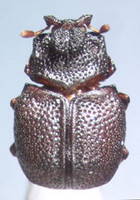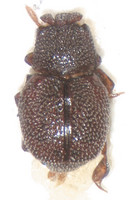Ceratohister
Michael S. Caterino- Ceratohister ankylonotum Dégallier & Caterino
- Ceratohister cornutus Dégallier & Caterino
- Ceratohister demotus (Caterino)
- Ceratohister leai Dégallier & Caterino
- Ceratohister pheidoliphilus Reichensperger
Introduction
Ceratohister was first named by Reichensperger (1924) for a species collected with Pheidole ants in India, C. pheidoliphilus. Neither his type specimen, nor that species have ever been seen again. The genus is unusual (though not unique) among Chlamydopsinae in lacking elytral trichomes. As these are generally considered the hallmarks of myrmecophilous beetles, it is particularly interesting to note that at least one of the species uses ants as a host.
Subsequent species placed in Ceratohister have been collected well to the east and southeast of the original species, from Borneo and Sulawesi.
The genus Ceratohister is not very well supported at present. Given uncertainty about its monophyly, it is not possible to place Ceratohister among other 'hidden scutellum group' taxa. Its species generally appear closely related to others lacking elytral trichomes (those in Pheidoliphila), but it is unlikely that this loss has only happened once.
Characteristics
The genus Ceratohister is defined very practically by the lack of elytral trichomes in combination with a generally smooth dorsum (as opposed to carinate as seen in some Pheidoliphila which also lack typical trichomes.)
References
Caterino. M. S. and Dégallier, N. 2007. A review of the biology and systematics of Chlamydopsinae. Invertebrate Systematics 21:1-28.
Reichensperger, A. 1924. Zur kenntnis myrmekophiler Histeriden. Entomologische Mitteilungen 8:302–308.
Information on the Internet
- Color images of all species. Supplement to descriptive paper, hosted by M. Caterino and the Santa Barbara Museum of Natural History.
Title Illustrations

| Scientific Name | Ceratohister ankylonotum |
|---|---|
| Location | Sabah, Malaysia |
| Specimen Condition | Dead Specimen |
| Identified By | Michael S. Caterino |
| Image Use |
 This media file is licensed under the Creative Commons Attribution-ShareAlike License - Version 3.0. This media file is licensed under the Creative Commons Attribution-ShareAlike License - Version 3.0.
|
| Copyright |
© 2002
Michael S. Caterino

|
| Scientific Name | Ceratohister leai |
|---|---|
| Specimen Condition | Dead Specimen |
| Identified By | Michael S. Caterino |
| Collection | The Natural History Museum, London |
| Type | Holotype |
| Image Use |
 This media file is licensed under the Creative Commons Attribution-ShareAlike License - Version 3.0. This media file is licensed under the Creative Commons Attribution-ShareAlike License - Version 3.0.
|
| Copyright |
©
Michael S. Caterino

|
About This Page
Michael S. Caterino

Santa Barbara Museum of Natural History, Santa Barbara, California, USA
Correspondence regarding this page should be directed to Michael S. Caterino at
mcaterino@sbnature2.org
Page copyright © 2007 Michael S. Caterino
 Page: Tree of Life
Ceratohister .
Authored by
Michael S. Caterino.
The TEXT of this page is licensed under the
Creative Commons Attribution License - Version 3.0. Note that images and other media
featured on this page are each governed by their own license, and they may or may not be available
for reuse. Click on an image or a media link to access the media data window, which provides the
relevant licensing information. For the general terms and conditions of ToL material reuse and
redistribution, please see the Tree of Life Copyright
Policies.
Page: Tree of Life
Ceratohister .
Authored by
Michael S. Caterino.
The TEXT of this page is licensed under the
Creative Commons Attribution License - Version 3.0. Note that images and other media
featured on this page are each governed by their own license, and they may or may not be available
for reuse. Click on an image or a media link to access the media data window, which provides the
relevant licensing information. For the general terms and conditions of ToL material reuse and
redistribution, please see the Tree of Life Copyright
Policies.
- First online 15 July 2007
- Content changed 15 July 2007
Citing this page:
Caterino, Michael S. 2007. Ceratohister . Version 15 July 2007 (under construction). http://tolweb.org/Ceratohister/9258/2007.07.15 in The Tree of Life Web Project, http://tolweb.org/










 Go to quick links
Go to quick search
Go to navigation for this section of the ToL site
Go to detailed links for the ToL site
Go to quick links
Go to quick search
Go to navigation for this section of the ToL site
Go to detailed links for the ToL site